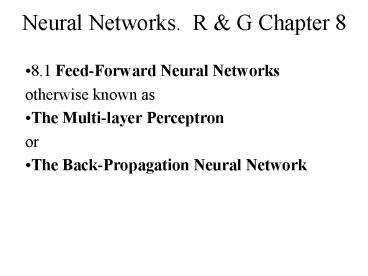Neural Networks. R - PowerPoint PPT Presentation
1 / 52
Title:
Neural Networks. R
Description:
What input attributes will be used to build the network? ... Appropriate for applications requiring a time element. Have performed well in several domains. ... – PowerPoint PPT presentation
Number of Views:21
Avg rating:3.0/5.0
Title: Neural Networks. R
1
Neural Networks. R G Chapter 8
- 8.1 Feed-Forward Neural Networks
- otherwise known as
- The Multi-layer Perceptron
- or
- The Back-Propagation Neural Network
2
A diagramatic representation of a Feed-Forward NN
x1
x2
y
x3
Inputs and outputs are numeric.
3
Inputs and outputs
- Must be numeric, but can have any range in
general. - However, R G prefer to consider constraining to
(0-1) range inputs and outputs.
4
Neural Network Input FormatReal input data
values are standardized (scaled) so that they all
have ranges from 0 1.
5
Categorical input format
- We need a way to convert categores to numberical
values. - For hair-colour we might have values red,
blond, brown, black, grey. - 3 APPROACHES
- 1. Use of (5) Dummy variables (BEST)
- Let XR1 if hair-colour red, 0 otherwise, etc
- 2. Use a binary array 3 binary inputs can
represent 8 numbers. Hence let red (0,0,0),
blond, (0,0,1), etc - However, this sets up a false associations.
- 3. VERY BAD red 0.0, blond 0.25, , grey
1.0 - Converts nominal scale into false interval scale.
6
Calculating Neuron OutputThe neuron threshhold
function. The following sigmoid function, called
the standard logistic function, is often used to
model the effect of a neuron.
Consider node i, in the hidden layer. It has
inputs x1, x2, and x3, each with a
weight-parameter.
Then calculate the output from the following
function
7
Note the output values are in the range
(0,1). This is fine if we want to use our output
to predict a probability of an event happening.
.
8
Other output types
- If we have a categorical output with several
values, then we can use dummy output notes for
each value of the attribute. - E.g. if we were predicting one of 5 hair-colour
classes, we would have 5 output nodes, with 1
being certain yes, and 0 being certain no.. - If we have a real output variable, with values
outside the range (0-1), then another
transformation would be needed to get realistic
real outputs. Usually the inverse of the scaling
transformation. i.e.
9
Training the Feed-forward net
- The performance parameters of the feed-forward
neural network are the weights. - The weights have to be varied so that the
predicted output is close to the true output
value corresponding to the inpute values. - Training of the ANN (Artificial Neural Net) is
effected by - Starting with artibrary wieghts
- Presenting the data, instance by instance
- adapting the weights according the error for
each instance. - Repeating until convergence.
10
8.2 Neural Network Training A Conceptual View
11
Supervised Learning/Training with Feed-Forward
Networks
- Backpropagation Learning
- Calculated error of each instance is used to
ammend weights. - Least squares fitting.
- All the errors for all instances are squared and
summed (ESS). All weights are then changed to
lower the ESS. - BOTH METHODS GIVE THE SAME RESULTS.
- IGNOR THE R G GENETIC ALGORITHM STUFF.
12
Unsupervised Clustering with Self-Organizing Maps
13
(No Transcript)
14
r
n
n
n n r(x-n)
x
Data Instance
15
8.3 Neural Network Explanation
- Sensitivity Analysis
- Average Member Technique
16
8.4 General Considerations
- What input attributes will be used to build the
network? - How will the network output be represented?
- How many hidden layers should the network
contain? - How many nodes should there be in each hidden
layer? - What condition will terminate network training?
17
Neural Network Strengths
- Work well with noisy data.
- Can process numeric and categorical data.
- Appropriate for applications requiring a time
element. - Have performed well in several domains.
- Appropriate for supervised learning and
unsupervised clustering.
18
Weaknesses
- Lack explanation capabilities.
- May not provide optimal solutions to problems.
- Overtraining can be a problem.
19
Building Neural Networks with iDA
- Chapter 9
20
9.1 A Four-Step Approach for Backpropagation
Learning
- Prepare the data to be mined.
- Define the network architecture.
- Watch the network train.
- Read and interpret summary results.
21
Example 1 Modeling the Exclusive-OR Function
22
(No Transcript)
23
(No Transcript)
24
Step 1 Prepare The Data To Be Mined
25
(No Transcript)
26
Step 2 Define The Network Architecture
27
(No Transcript)
28
(No Transcript)
29
Step 3 Watch The Network Train
30
(No Transcript)
31
Step 4 Read and Interpret Summary Results
32
(No Transcript)
33
(No Transcript)
34
Example 2 The Satellite Image Dataset
35
Step 1 Prepare The Data To Be Mined
36
(No Transcript)
37
Step 2 Define The Network Architecture
38
(No Transcript)
39
Step 3 Watch The Network Train
40
Step 4 Read And Interpret Summary Results
41
(No Transcript)
42
(No Transcript)
43
9.2 A Four-Step Approach for Neural Network
Clustering
44
Step 1 Prepare The Data To Be Mined
- The Deer Hunter Dataset
45
Step 2 Define The Network Architecture
46
(No Transcript)
47
Step 3 Watch The Network Train
48
(No Transcript)
49
Step 4 Read And Interpret Summary Results
50
(No Transcript)
51
(No Transcript)
52
9.3 ESX for Neural Network Cluster Analysis

